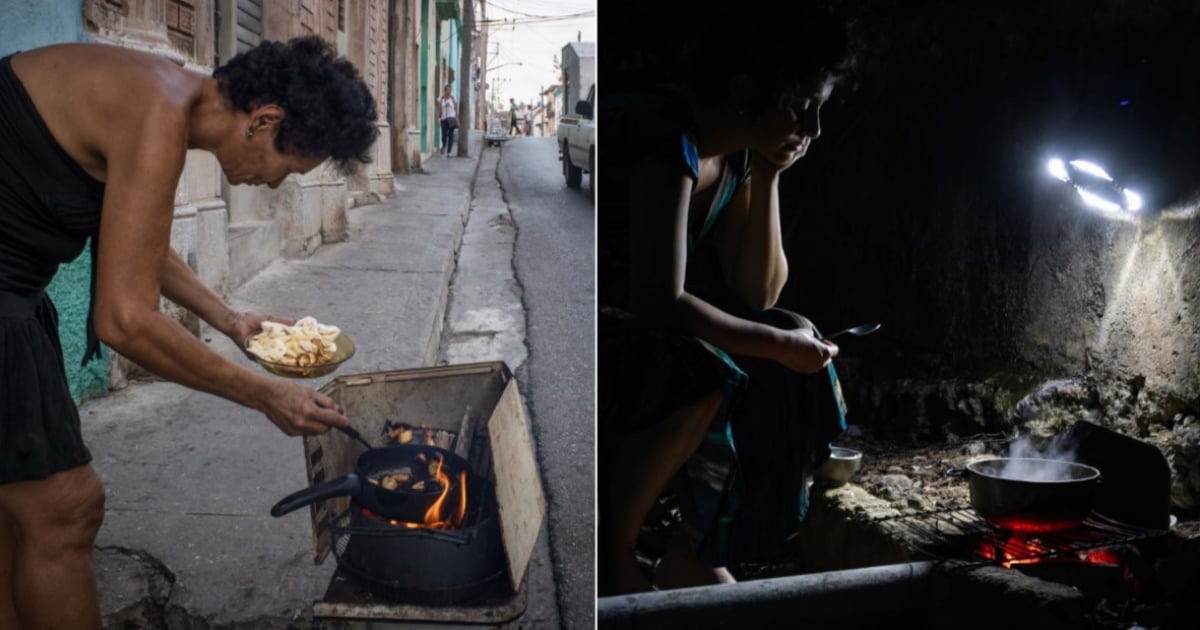In a revealing photo essay titled "Improvised Flames and a Cold Plate of Food," the Girón Newspaper sheds light on the harsh realities faced by Cubans trying to cook amid the island's ongoing energy crisis. Captured through the lens of photographer Raúl Navarro, the images depict citizens resorting to makeshift wood fires or using charcoal due to the lack of electricity and scarce supply of liquefied gas.
The article highlights the struggle, noting, "Without power to run pressure cookers and induction stoves, many turn to gas; yet, not everyone has a contract for this." The official outlet's photo essay presents striking images of people cooking outdoors in precarious conditions, lit by improvised lights and using rudimentary tools, their hands blackened with soot from the wood and charcoal.
The report emphasizes, "No matter the solution, what's imperative is ensuring the child doesn't go to bed without something warm in their stomach." It also notes the significant impact on family dynamics, forcing many to prepare meals at unusual hours: "You'll cook your rice late at night when your two-hour power window arrives, or you'll make a main dish to last several days, praying it doesn't spoil in a powerless fridge, now just a tin cabinet."
In a nod to Cuban resilience, the piece asserts, "If Prometheus hadn't stolen fire from the gods, we would have invented it ourselves." It describes how people "will find an old burner, build a fire with a couple of bricks, or take out that old grill from the storage, reminiscent of days when pork was roasted to celebrate births and homecomings."
The publication has sparked a wave of criticism on social media, with many accusing the outlet of glossing over a desperate situation instead of challenging the government responsible for the crisis driving citizens to live in medieval-like conditions. Comments like "The aroma of meat over charcoal, what disrespect," and "The crisis is so severe, we're living like madmen in this country," reflect widespread frustration.
Other reactions express deep sorrow: "Cuba makes you want to cry; it tightens your chest thinking about this harsh reality we must endure." Another pointed out the health repercussions: "We're living in terrifying times. The anxiety, desperation, and stress raise our blood sugar, and we lack medication."
The Girón photo essay follows a previous attempt by the same outlet to romanticize blackouts, suggesting they "bring back a piece of what we miss" by allowing children to play in the streets when there's no electricity. Meanwhile, the energy crisis has driven charcoal prices sky-high, making it a luxury; in Holguín, a sack can cost up to 1,400 pesos, putting it out of reach for many.
Everyday stories illustrate the dire conditions many Cubans face, such as María Julia Gómez Pérez, a woman battling metastatic cancer, who voiced her despair at having to cook with wood due to a lack of government-supplied liquefied gas. Her plight resonated on social media, sparking both solidarity and criticism of the state's failure to provide solutions.
The report by Periódico Girón starkly reveals the severe reality confronting Cubans amid the energy system's collapse. Citizens are weary of narratives that gloss over the crisis rather than demand real solutions. The absence of electricity and gas not only hinders food preparation but has become a daily survival challenge for countless Cuban families.
The report concludes with a clear call for concrete answers: "Beyond the ingenuity the Cuban people have been forced to sustain as a last resort, we need feasible solutions because life cannot remain on hold at the stove."
Understanding Cuba's Energy Crisis and Its Impact
What are the main challenges Cubans face due to the energy crisis?
Cubans face significant challenges such as cooking without electricity, relying on wood or charcoal, and dealing with the high cost of these resources. Additionally, the lack of power affects family routines and food preservation.
How has the energy crisis impacted the cost of charcoal in Cuba?
The energy crisis has significantly increased the price of charcoal, making it an expensive commodity. In some areas like Holguín, a sack of charcoal can cost up to 1,400 pesos, putting it out of reach for many residents.
What reactions did the Girón photo essay provoke among Cubans?
The Girón photo essay sparked widespread criticism on social media, with many Cubans accusing the outlet of romanticizing a desperate situation instead of holding the government accountable for the crisis.
